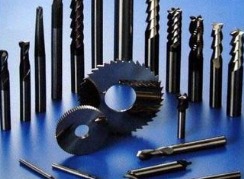 The improvement of the accuracy of the rod-like tool has always been a difficult point in the manufacture of the tool. The main reason is that the active part of the tool is too long and the cutting edge of the tool is too far away from the clamping part during manufacture. Because the cutting edge is too far from the clamping part, plus the chuck has a certain clamping accuracy (usually 0.002 ~ 0.005mm), so before the start of grinding, the radial runout at the cutting edge of the tool may have reached 0.005mm to 0.01mm (even larger).
The improvement of the accuracy of the rod-like tool has always been a difficult point in the manufacture of the tool. The main reason is that the active part of the tool is too long and the cutting edge of the tool is too far away from the clamping part during manufacture. Because the cutting edge is too far from the clamping part, plus the chuck has a certain clamping accuracy (usually 0.002 ~ 0.005mm), so before the start of grinding, the radial runout at the cutting edge of the tool may have reached 0.005mm to 0.01mm (even larger).
Due to the strong grinding process used for grinding tools, especially for grinding the sipes, the grinding force is large and the elastic deformation of the tools is large. Many problems occur in the machining process, such as the asymmetry of the tool flutes, the outer dimensions of the tools, The blade parameters and shape errors do not meet the requirements. In severe cases, the tool is even broken. The following is a simple analysis of the issues related to tool accuracy when machining slender rod-shaped tools.
First, the impact of processing machine tools on tool accuracy. Effect of machine tool accuracy on tool accuracy When making any tool, the accuracy of the machine tool is the key to determining tool accuracy. Slender rod tools are no exception. The influence of the support block on the tool accuracy The support block equipped with this machine is mainly used for machining slender rod-shaped tools. Its position can be adjusted in both horizontal and vertical directions, and it can be positioned according to actual conditions. If the position of the support block in the transverse direction (ie, the axial direction of the tool) is not properly selected, a qualified slender bar tool cannot be machined. If the support block is too low, the support force for the tool is not enough, which will cause the sipe to form an inverted cone in the axial direction. If the support block is too high, the support block will be hard against the tool, which will cause the sipe to form a forward taper in the axial direction. Therefore, the accurate positioning of the support block is also important for the accuracy of the tool.
Second, the impact of grinding wheel on tool accuracy. All parameters of the tool are determined by the relative motion of the grinding wheel and the tool. Therefore, the diameter of the grinding wheel, the angle at which the grinding wheel directly participates in the cutting, the length of the flange of the grinding wheel shaft, the wear of the grinding wheel, and the grain size of the grinding wheel all influence the accuracy of the tool. Grinding Wheel Angle Measurement or Input Accuracy The grinding wheel angle measurement or inaccurate input may result in: The blade width is not consistent with the requirements; the stepped tool step surface angle does not meet the requirements; the tool back angle position or angle error; chip flutes Groove angle error and so on.
Third, the coolant cooling effect on the grinding area will directly affect the accuracy of the tool. The selection of excellent coolant and proper cooling pressure facilitates the entry of cooling fluid into the grinding zone, removing cutting heat and cuttings in time, effectively reducing the surface roughness of the tool.
A Brief Analysis of the Accuracy of the Slender Rod Tool